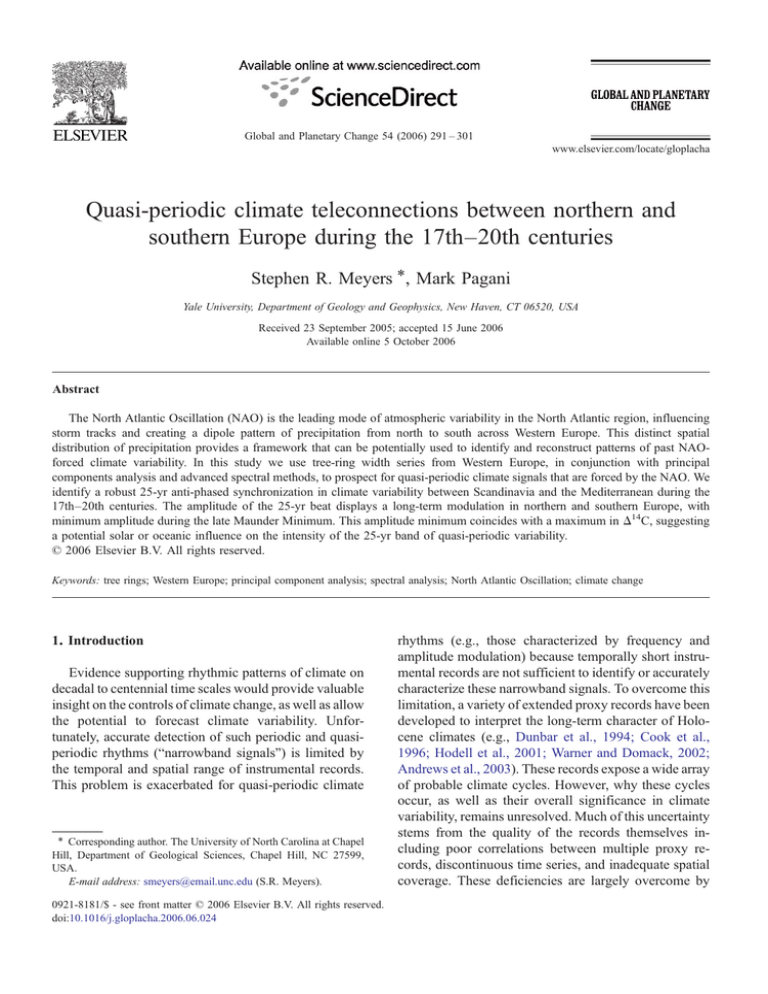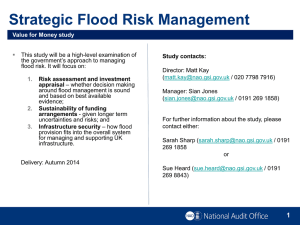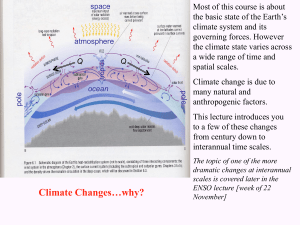Quasi-periodic climate teleconnections between northern and –20th centuries
advertisement

Global and Planetary Change 54 (2006) 291 – 301 www.elsevier.com/locate/gloplacha Quasi-periodic climate teleconnections between northern and southern Europe during the 17th–20th centuries Stephen R. Meyers ⁎, Mark Pagani Yale University, Department of Geology and Geophysics, New Haven, CT 06520, USA Received 23 September 2005; accepted 15 June 2006 Available online 5 October 2006 Abstract The North Atlantic Oscillation (NAO) is the leading mode of atmospheric variability in the North Atlantic region, influencing storm tracks and creating a dipole pattern of precipitation from north to south across Western Europe. This distinct spatial distribution of precipitation provides a framework that can be potentially used to identify and reconstruct patterns of past NAOforced climate variability. In this study we use tree-ring width series from Western Europe, in conjunction with principal components analysis and advanced spectral methods, to prospect for quasi-periodic climate signals that are forced by the NAO. We identify a robust 25-yr anti-phased synchronization in climate variability between Scandinavia and the Mediterranean during the 17th–20th centuries. The amplitude of the 25-yr beat displays a long-term modulation in northern and southern Europe, with minimum amplitude during the late Maunder Minimum. This amplitude minimum coincides with a maximum in Δ14C, suggesting a potential solar or oceanic influence on the intensity of the 25-yr band of quasi-periodic variability. © 2006 Elsevier B.V. All rights reserved. Keywords: tree rings; Western Europe; principal component analysis; spectral analysis; North Atlantic Oscillation; climate change 1. Introduction Evidence supporting rhythmic patterns of climate on decadal to centennial time scales would provide valuable insight on the controls of climate change, as well as allow the potential to forecast climate variability. Unfortunately, accurate detection of such periodic and quasiperiodic rhythms (“narrowband signals”) is limited by the temporal and spatial range of instrumental records. This problem is exacerbated for quasi-periodic climate ⁎ Corresponding author. The University of North Carolina at Chapel Hill, Department of Geological Sciences, Chapel Hill, NC 27599, USA. E-mail address: smeyers@email.unc.edu (S.R. Meyers). 0921-8181/$ - see front matter © 2006 Elsevier B.V. All rights reserved. doi:10.1016/j.gloplacha.2006.06.024 rhythms (e.g., those characterized by frequency and amplitude modulation) because temporally short instrumental records are not sufficient to identify or accurately characterize these narrowband signals. To overcome this limitation, a variety of extended proxy records have been developed to interpret the long-term character of Holocene climates (e.g., Dunbar et al., 1994; Cook et al., 1996; Hodell et al., 2001; Warner and Domack, 2002; Andrews et al., 2003). These records expose a wide array of probable climate cycles. However, why these cycles occur, as well as their overall significance in climate variability, remains unresolved. Much of this uncertainty stems from the quality of the records themselves including poor correlations between multiple proxy records, discontinuous time series, and inadequate spatial coverage. These deficiencies are largely overcome by 292 S.R. Meyers, M. Pagani / Global and Planetary Change 54 (2006) 291–301 Fig. 1. Locations of the 22 tree-ring width records used in this study. applying annually resolved tree-ring chronologies, which provide an exceptional opportunity to quantify the cyclic behavior of climate on short-time scales (Mann et al., 1995; Cook et al., 1996, 1997, 1998, 2002). In this study, we utilize tree-ring width series to evaluate narrowband climate variability attributable to the North Atlantic Oscillation (NAO), an internal mode of climate that exacts control on the strength of the Westerlies and weather patterns in Europe (Hurrell, 1995; Hurrell et al., 2003). The NAO refers to changes in atmospheric mass distribution between the subtropical Atlantic high and the arctic low and represents the leading pattern of atmospheric variability within the middle and high latitudes of the North Atlantic (Rogers, 1984; Hurrell, 1995; Hurrell et al., 2003). When the subtropic–arctic pressure gradient is most pronounced (positive NAO), northern Europe experiences enhanced precipitation and warmth, while southern Europe becomes drier (Fig. 1). As a result, weather patterns between the Mediterranean and Scandinavia are significantly coherent, but anti-phased in nature, forming a dipole pattern of precipitation across Western Europe. Previous analyses of instrumental-based NAO indices have identified enhanced power at periods of ∼ 2 yr, ∼ 8, Table 1 Principal component loadings for northern and southern Europe tree-ring width time series Northern Europe tree ring record Species PC 1 loading Southern Europe tree ring record Species PC 1 loading Norway: norw001 Norway: norw008 Norway: norw009 Norway: norw010 Sweden: swed002 Sweden: swed004 Sweden: swed007 Sweden: swed020w Sweden: swed022w Scotch Pine Scotch Pine Scotch Pine Scotch Pine Scotch Pine Scotch Pine Scotch Pine Scotch Pine Scotch Pine 0.65 0.79 0.75 0.76 0.79 0.73 0.77 0.79 − 0.03 Spain: spai011 Spain: spai012 Spain: spai019 Spain: spai026 Spain: spai038 Spain: spai047 Spain: spai049 Italy: ital015 Italy: ital022 Italy: ital023 Italy: ital024 Italy: ital025 Greece: gree005 Black Pine Scotch Pine Black Pine Austrian Pine Scotch Pine Scotch Pine Scotch Pine Bosnian Pine Fir species Swiss Stone Pine European Larch Norway Spruce Bosnian Pine 0.58 0.60 0.64 0.56 0.68 0.64 0.50 0.11 0.09 −0.05 −0.06 −0.17 −0.11 Loadings represent the correlation of individual tree ring chronologies with the leading PC. S.R. Meyers, M. Pagani / Global and Planetary Change 54 (2006) 291–301 ∼ 20, and ∼ 70 yr (e.g., Rogers, 1984; Schneider and Schonwiese, 1989; Hurrell and Van Loon, 1997; Cullen et al., 2001), although some studies have concluded that these signals are statistically insignificant or of minor importance (e.g., Wunch, 1999; Hurrell et al., 2003). The persistence and validity of narrowband NAO variability can be further tested using proxy-based NAOindex reconstructions to extend the breadth of the instrumental record. However, the lack of significant correlation between a number of independently developed proxy NAO indices prior to 1850 (Schmutz et al., 2000; see Cook, 2003, for further discussion) clearly complicates accurate quantification of any narrowband variability. Further, a recent study by von Storch et al. (2004) suggests that regression methods commonly used to calibrate proxy data underestimate interdecadal to 293 centennial-scale signals. However, this perspective is currently a subject of considerable debate (e.g., see Mann et al., 2005). Irrespective of this, the variable sensitivity of local environments to the climate forcing mechanism, as well as inconsistent signal phase relationships between locations, can also potentially conceal important quasi-periodic signals attributable to the NAO. Herein, we outline an alternative approach to prospect for cyclic signals that resemble forcing by the NAO. We apply a method that is independent from an explicit calibration of the tree-ring series to climate variables, and restrict our analysis to tree-ring networks from the northern and southern regions of Western Europe that are strongly influenced by the NAO. We are specifically interested in narrowband signals that are coherent and anti-phased; characteristic of the NAO Fig. 2. Leading principal component scores from (A) northern Europe and (B) southern Europe, and their 10-yr moving averages (C). Arrows identify anti-correlated portions of the tree-ring records (extreme PC score values), which suggest inter-decadal synchronization of climate change between northern and southern Europe. 294 S.R. Meyers, M. Pagani / Global and Planetary Change 54 (2006) 291–301 dipole pattern of precipitation across the region. To aid in the interpretation of this proxy data, we also provide a brief analysis of Hurrell's (1995) instrumental NAO index using methods that are optimal for the detection of narrowband signals embedded in short, noisy data series (Thomson, 1982; Mann and Lees, 1996). 2. Analytical methods and study design For this study, we selected existing tree ring width records from Scandinavia and the Mediterranean that date back to at least 1600 AD. These locations were targeted because instrumental records of the NAO are significantly correlated to precipitation and/or temperature (Hurrell, 1995; Hurrell et al., 2003), and studies have documented sensitivity of Scandinavian tree ring chronologies to temperature and precipitation (Briffa et al., 1988; D'Arrigo et al., 1993; Briffa et al., 2001; Linderholm et al., 2003) and Mediterranean tree ring chronologies to precipitation (Richter et al., 1991; Glueck and Stockton, 2001). Based on these and other observations, chronologies from Western Europe have become a critical component of proxy-based NAO reconstructions (Cook et al., 1998; Glueck and Stockton, 2001; Cullen et al., 2001; Mann, 2002; Cook et al., 2002). The Scandinavian tree ring network consists of nine tree ring chronologies from Norway and Sweden, and the Mediterranean network contains 13 chronologies from Spain, Italy, and Greece (Table 1, Fig. 1). These records were obtained from the International Tree-Ring Data Bank (http://www.ncdc.noaa.gov/paleo/ftp-treering.html) and are “standard chronologies”, processed to remove long-term biological growth curves (Cook and Kairiukstis, 1990). Principal component analysis (PCA) was used to identify the leading mode of variability within each tree ring network, functioning as a filter to exclude non-regional ring width signals (e.g., anomalous chronologies). We assume that the leading mode of ring width variability (first principal component; PC1) represents regional climate change, and use subsequent processing to further distinguish (narrowband) climate variability from other potential controls on tree ring growth. In contrast to studies that use screening procedures to exclude tree ring chronologies (e.g., those that have low correlation with the NAO index; Cook et al., 1998), we use PCA and the spatial weather patterns characteristic of the NAO to identify tree ring width characteristics that resemble this internal mode. We restrict our analysis to the leading PC, as the other principal components are more likely to capture variance due to anomalous chronologies that do not reflect regional climate change. Multi-Taper Method (MTM) power spectral analysis (Thomson, 1982; Mann and Lees, 1996) was applied to identify significant quasi-periodic variability in the leading principal component times series (PC1 scores) from both northern and southern Europe, while MTM coherency and cross-phase analyses were used to determine coherency and phase relationships between these time series. The MTM power spectral technique employs a median-smoothed “robust” red noise background estimate (Mann and Lees, 1996) to calculate confidence levels (C.L.) for each power spectrum. We also apply “compound” confidence levels (C.C.L.), which permit estimation of the significance of quasiperiodic signals that appear in power spectra from both regions (e.g., 90% C.C.L. = 68.4% C.L; 99% C.C.L. = 90% C.L.). Ring width signals that resemble NAO-induced climate patterns should display significant power (N 90% C.C.L.) in both northern and southern Europe time Table 2 Eigenvalues for northern and southern Europe tree ring PCs, and the fraction of the tree ring width variance attributable to each component Northern Europe principal component Eigenvalue Variance (%) Southern Europe principal component Eigenvalue Variance (%) PC1 PC2 PC3 PC4 PC5 PC6 PC7 PC8 PC9 4.56 1.36 0.97 0.61 0.45 0.31 0.27 0.26 0.20 50.71 15.15 10.83 6.72 4.99 3.47 3.01 2.94 2.19 PC1 PC2 PC3 PC4 PC5 PC6 PC7 PC8 PC9 PV10 PC11 PC12 PC13 2.61 2.12 1.37 1.14 1.01 0.95 0.78 0.65 0.58 0.56 0.53 0.44 0.26 20.11 16.30 10.56 8.75 7.80 7.29 5.99 4.99 4.48 4.30 4.04 3.39 2.00 S.R. Meyers, M. Pagani / Global and Planetary Change 54 (2006) 291–301 series, significant coherency (N 90% C.L.) between the records within the band of quasi-periodic variability, and an anti-phased relationship. Although a wide range of factors potentially impact tree growth (Fritts, 1976), climate variability is the only plausible mechanism that 295 can generate synchronous ring width signals in distant sites spanning a broad range of environments. It is important to recognize that several factors can act to attenuate the NAO climate signal in these tree ring records. For example, the NAO is most pronounced Fig. 3. Power, coherency and cross-phase results for the leading principal components from northern and southern Europe. (A) MTM power spectrum for the leading principal component from northern Europe (Norway and Sweden). (B) MTM power spectrum for the leading principal component from southern Europe (Spain, Italy and Greece). (C) MTM squared magnitude coherency for the leading principal components from northern and southern Europe. (D) MTM cross-phase estimate for the leading principal components from northern and southern Europe. All calculations use three 2π data tapers. Dotted lines indicate the median-smoothed red noise background estimate and its associated 90%, 95% and 99% confidence levels (Mann and Lees, 1996), and the dashed lines indicate the 90% compound confidence level. The dotted lines in (C) indicate the 90%, 95% and 99% confidence levels for non-zero coherence. Vertical grey bars identify frequency bands that have significant power and coherence and are anti-phased. 296 S.R. Meyers, M. Pagani / Global and Planetary Change 54 (2006) 291–301 during the winter (Hurrell et al., 2003), and during much of the summer the anti-phased climate signals are minimized or absent from the study regions (Fig. 6 of Hurrell et al., 2003). This observation is critical in light of the expectation that tree ring records in this study should be most sensitive to growing conditions during the spring and summer. Thus, for our analytical approach to be successful, tree ring growth must preserve some sensitivity to September–March weather conditions. Studies of tree ring data from the Mediterranean and Fennoscandinavia support this assertion (D'Arrigo et al., 1993; Glueck and Stockton, 2001), and indeed, the validity of published tree-ring-based reconstructions of the December–March NAO index (e.g., Cook et al., 2002) is dependent upon this growth sensitivity. Finally, instrumental measurements within Europe indicate that the NAO can account for as little as 3% of the variance in precipitation, or as much as 59%, depending upon location (Hurrell, 1995). Although we have selected study locations where NAO forcing should be maximized, NAO signals are expected to represent a minor fraction of the leading PC variance. Given the considerations outlined above, any quasiperiodic climate signals preserved in our proxy records likely represent a minimum response. As a result, even subtle signals identified in our analysis are probably indicative of more pronounced climate forcing. 3. Assessment of narrowband variability in tree ring width data Scores for the leading PCs from the northern and southern European tree ring networks are displayed in Fig. 2. High principal component scores, reflecting large ring widths, are interpreted as warmer/wetter regional conditions, while low principal component scores/small ring widths are interpreted as colder/drier conditions. The Scandinavian PC1 (Fig. 2A) shows a strong positive Fig. 4. (A) Bandpass-filtered principal components, computed with a 10% cosine window centered on 1/25 yr (0.035–0.045 cycles/yr). The solid line indicates the results for the leading principal component from southern Europe, and the dotted line indicates the results for the leading principal component from northern Europe. “M.M.” identifies the location of the Maunder Minimum (Eddy, 1976). (B) Annual Δ14C data (Stuiver et al., 1998). S.R. Meyers, M. Pagani / Global and Planetary Change 54 (2006) 291–301 correlation with 8 of 9 tree-ring records from Norway and Sweden (Table 1), accounting for 50.71% of ringwidth variance (Table 2). The Mediterranean PC1 (Fig. 2B) accounts for 20.11% of the ring-width variance and primarily reflects 7 tree-ring records from Spain (Table 2). MTM power spectra, coherency, and cross-phase (Fig. 3) analyses for the leading PCs indicate the presence of two quasi-periodic signals containing statistically significant power, high coherence, and an antiphased relationship between northern and southern Europe. These two quasi-periods resemble a NAO-induced signal and display highest coherence at frequencies of 1/25 yr (88.56% shared variance between the leading PCs) and 1/4.9 yr (84.94% shared variance between the leading PCs). For this study, we focus on the dominant quasi-period at 25 yr (spectral bandwidth resolution = 22.0–28.9 yr). Fig. 5. MTM power spectral analysis of (A) the extended winter NAO index (1864 AD–2003 AD), and (B) the individual monthly NAO indices (1865 AD–2002 AD). All power spectral analyses employed three 2π data tapers. Dotted lines in Fig. 2A indicate the mediansmoothed red noise background estimate and associated 90%, 95% and 99% confidence levels (Mann and Lees, 1996). 297 Twenty-five-year bandpass-filtered records of the leading PCs from northern and southern Europe make clear that dry/cold climate events in northern Europe are closely associated with wet events in southern Europe, and vice versa (Fig. 4A). Further, the amplitude of the 25-yr quasi-period is modulated, with an amplitude minimum coincident with the later portion of the Maunder Minimum (defined by a substantial reduction in sunspot activity (Eddy, 1976)). This amplitude minimum is associated with a loss of the anti-phased character between the northern and southern European records, indicating that the strength of the dipole signal has been diminished below a critical noise level. This time interval is also characterized by a maximum in the annual Δ14C record (Stuiver et al., 1998) (Fig. 4B). Changes in Δ14C on these time scales could be driven by changes in solar intensity and/or ocean ventilation (Stuiver, 1961; Stuiver and Quay, 1980; Hughen et al., 2000). In either case, our results suggest an additional forcing, influencing the intensity of a 25-yr band of quasi-periodic variability of precipitation and/or temperature in Western Europe. Although this 25-yr pattern conforms to our spectral conditions for a NAO-like climate signal, it is not entirely conclusive that it is indeed linked to the activity of the NAO. Analysis of an updated version of Hurrell's (1995) extended winter NAO index (www.cgd.ucar.edu/∼jhurrell/) using MTM spectral analysis (Figs. 5A and 6A) indicates that the NAO is characterized by a number of potential quasiperiods that exceed the 90% confidence level. For example, a highly significant ∼8-yr signal in the NAO record shows strong and significant coherence to an 8-yr quasi-period in the annual Central England temperature record (Plaut et al., 1995; http://www.metoffice.com/ research/hadleycentre/CR_data/Daily/) (Fig. 5A). Such a correspondence highlights the linkage between climate and narrowband NAO forcing in Western Europe; however, none of the periods in the extended winter NAO index correspond to the 25-yr cycle uncovered in our tree ring analysis. This apparent disparity could be potentially explained by the way in which the NAO is defined. Although the winter NAO index provides the most robust expression of sea surface pressure variability in the North Atlantic, changes in the subtropic–arctic pressure gradient occur year round. Analysis of monthly NAO indices (www.cgd.ucar.edu/∼jhurrell/) demonstrates that the spectral character of the NAO is highly variable throughout the year (Fig. 5B). For example, power concentrated at ∼8 yr is largely absent from June through November, while high power centered at ∼50 yr is persistent throughout most of the year. Relevant to this study is the appearance of high power in the 20–30-yr band during the Autumn months. 298 S.R. Meyers, M. Pagani / Global and Planetary Change 54 (2006) 291–301 the 25-yr beat in the Mediterranean are associated with a weak NAO in Western Europe (with a 2.8 yr lag), while wet conditions in Scandinavia occur when the NAO is most pronounced. The next largest concentration of variance in the 20– 30 yr band corresponds to the late fall index of the NAO. As stated earlier, this association suggests that tree growth is influenced by autumn precipitation. One plausible explanation for this linkage is related to the production of new root growth, which primarily occurs during the autumn. Exceptionally wet conditions during the late autumn result in enhanced rootlet growth, preconditioning the tree to efficiently utilize available nutrients and water during the following spring growing season. However, the phase relationship between the late fall NAO index and the tree-ring signal (18°) is opposite to that expected, that is, high NAO indices would need to be associated with wetter conditions in the Mediterranean, instead of drier. Accordingly, if the late fall NAO is driving the tree-ring signal, it must be operating in a fashion contrary to the winter NAO. It is not immediately evident why a 25-yr quasiperiodic climate signal in trees should have its origin in autumn NAO variability. However, coherency and crossphase analysis with a variety of instrumental-based NAO records (www.cgd.ucar.edu/∼jhurrell/), the annual Central England temperature record (http://www.metoffice. com/research/hadleycentre/CR_data/Daily/), and the annual Δ14C time series (Stuiver et al., 1998) indicate that NAO-based time series (1, 2 and 5 in Table 3) are the only data sets that display significant coherency (N 90% confidence level) at a frequency of 1/25 yr (note: data series 4 falls slightly below the 90% significance level), consistent with the interpretation of a NAO-related origin for the 25-yr signal. The greatest concentration of variance in the 20–30 yr band occurs in the envelope function of the extended winter NAO index, with power maxima at 1/27 yr and 1/20 yr (given the short nature of the instrumental time series, the spectral bandwidth resolution of these power maxima overlap), suggesting that the tree-ring signal derives from the modulation of the intensity of the NAO. In this scenario, wet phases of Table 3 MTM coherency and cross-phase analysis results Variance c (%) Power maxima d (1/yr) − 52 − 85 149 18 140 2.2 3.8 1.8 5.4 7.4 0.07 0.35 119 169 1.1 0.7 1865–1971 0.32 − 37 3.0 1/29 yr 1/27 yr None 1/22 yr 1/27 yr 1/20 yr 1/23 yr 1/28 yr 1/24 yr 1/28 yr 1659–1971 0.12 − 167 8.8 Data series number Instrumental/proxy data series Time interval (A.D.) Magnitude squared coherency a 1 2 3 4 5 Annual NAO index e December–March NAO index f April–June NAO index g October–November NAO index h December–March NAO index envelope function i Δ14C j Δ14C j 1865–1971 1865–1971 1865–1971 1865–1971 1865–1971 0.93 0.97 0.52 0.66 0.70 1865–1954 1599–1954 Annual Central England temperature k Annual Central England temperature k 6 7 8 9 Phase b (degrees) (37.8%; 61.3%) (79.1%; 95.6%) (87.0%; 98.3%) (71.0%; 91.6%); (83.3%; 97.2%) (34.6%; 57.2%) (97.1%; 99.9%); (96.9%; 99.9%) (60.0%; 84.0%) 1/25 yr (99.7%; 100%); 1/22 yr (99.7%; 100%) Analyses were conducted against the leading principal component from the Mediterranean tree-ring network and employ three 2π data tapers. a Magnitude squared coherence at a frequency of 1/25 yr. Confidence levels for non-zero coherence: 90% = 0.68, 95% = 0.77, 99% = 0.90. b Phase at a frequency of 1/25 yr. c % Variance in the 1/20 yr–1/30 yr band. d Power maxima in the 1/20 yr–1/30 yr band. Confidence levels for the power maxima shown in parentheses (single spectrum confidence level; compound confidence level for the detection of quasi-periodic signals present in two time series). e Annual average NAO index based on sea level pressure measurements in Ponta Delgada, Azores and Stykkisholmur/Reykjavik, Iceland (http:// www.cgd.ucar.edu/∼jhurrell/nao.stat.ann.html, 2004). f Extended winter NAO index based on sea level pressure measurements in Lisbon, Portugal and Stykkisholmur/Reykjavik, Iceland (http://www. cgd.ucar.edu/∼jhurrell/nao.stat.winter.html, 2004). g Average NAO index from April to June, based on sea level pressure measurements in Ponta Delgada, Azores and Stykkisholmur/Reykjavik, Iceland (http://www.cgd.ucar.edu/∼jhurrell/nao.stat.other.html#seasonal, 2004). h Average NAO index during late fall, calculated from October and November average NAO indices based on sea level pressure measurements in Ponta Delgada, Azores and Stykkisholmur/Reykjavik, Iceland (http://www.cgd.ucar.edu/∼jhurrell/nao.stat.other.html#monthly, 2004). i Envelope function (instantaneous amplitude) of the Extended Winter NAO index (December–March), determined via complex demodulation. j Annual Δ14C time series (Stuiver et al., 1998). k Average annual Central England temperature (http://www.metoffice.com/research/hadleycentre/CR_data/Daily/HadCET_act.txt, 2004). S.R. Meyers, M. Pagani / Global and Planetary Change 54 (2006) 291–301 299 Fig. 6. MTM power spectral and coherency analysis of the extended winter NAO index and annual CET record. (A) Power spectrum for the NAO index (1864 AD–2001 AD). (B) Power spectrum for the CET record (1864 AD–2001 AD). (C) Coherency analysis for the NAO index and the CET record. (D) Cross-phase analysis for the NAO index and the CET record. Dotted lines in plots A and B represent “robust” red noise confidence levels for the power estimates (Mann and Lees, 1996). Dotted lines in plot (C) indicate the 90%, 95% and 99% confidence levels for non-zero coherence. All analyses applied three 2π tapers. 300 S.R. Meyers, M. Pagani / Global and Planetary Change 54 (2006) 291–301 Alternatively, the 25-yr quasi-periodic tree-ring signal could simply represent direct forcing by the winter NAO, with a 90° (6.3 yr) phase lag. 4. Discussion and conclusions The underlying mechanism(s) forcing this NAO-like ∼25 yr cycle remain unresolved. Twenty- to thirty-year periods have been identified in a variety of meteorological and climate proxy records (e.g., drought, temperature; Plaut et al., 1995; Mann et al., 1995; Cook et al., 1997; Hoyt and Schatten, 1997; Cronin et al., 2005), including instrumental- and tree-ring based NAO research (Rogers, 1984; Cook et al., 1998; Glueck and Stockton, 2001; Cullen et al., 2001; Mann, 2002). Although some studies credit climate forcing within this band to solar variability associated with the 22-yr Hale cycle in magnetic polarity, there is no supporting evidence linking the Hale cycle with changes in the sun's radiative output (Hoyt and Schatten, 1997). Alternatively, the only known origin of a quasi-periodic 25-yr cycle derives from the interference between the 18.6-yr lunar nodal cycle and the 10.7-yr Schwabe cycle (House, 1995; Li et al., 2005). This combination of lunar and solar variability has the potential to influence the distribution of surface waters available for heating by the sun (Bell, 1981), thus impacting the distribution of atmospheric moisture, pressure and temperature. If the lunar–solar forcing hypothesis is valid, we anticipate that 25-yr cycles in precipitation and temperature should generally lack coherence from region to region, given the potential for substantial differences in local tidal effects. However, the interaction of this cyclic lunar–solar forcing with existing modes of climate variability provides a mechanism for generating coherent regional teleconnections such as those identified in the Mediterranean and Scandinavia. Finally, linkages between precipitation, the Δ14C record, and the NAO could be potentially attributable to temperature variability of the upper ocean (Rodwell et al., 1999). At present, knowledge regarding high-frequency variation of sea surface temperatures (SST) is limited by a paucity of available records. However, recent work (Levitus et al., 2000; Sutton and Hodson, 2005) indicates that decadal-scale SST variability should also be considered as a possible driver of the hydrologic cycle on short-time scales. Acknowledgements This study was funded by the Yale Institute for Biospheric Studies Gaylord Donnelley Environmental Fellowship. The authors acknowledge stimulating discussions with E. Cook, J. Park, S. Sherwood and K. Turekian. The manuscript also greatly benefited from comments provided by Jasper Knight, and 3 anonymous reviewers. References Andrews, J.T., Hardadottir, J., Stoner, J.S., Mann, M.E., Kristjansdottir, G.B., Koc, N., 2003. Decadal to millennial-scale periodicities in North Iceland shelf sediments over the last 12000 cal yr: longterm North Atlantic oceanographic variability and solar forcing. Earth and Planetary Science Letters 210, 453–465. Bell, P.R., 1981. Predominant periods in the time series of drought area index for the western high plains AD 1700 to 1962. In: Sofia, S.S. (Ed.), Variations of the Solar Constant. National Aeronautics and Space Administration, Washington, D.C., pp. 257–264. Briffa, K.R., Jones, P.D., Pilcher, J.R., Hughes, M.K., 1988. Reconstructing summer temperatures in northern Fennoscadinavia back to AD 1700 using tree data from Scots Pine. Arctic and Alpine Research 20, 385–394. Briffa, K.R., Osborn, T.J., Schweingruber, F.H., Harris, I.C., Jones, P.D., Shiyatov, S.G., Vaganov, E.A., 2001. Low-frequency temperature variations from a northern tree ring density network. Journal of Geophysical Research 106, 2929–2941. Cook, E.R., 2003. Multi-proxy reconstructions of the North Atlantic Oscillation (NAO) index: a critical review and a new well-verified winter NAO index reconstruction back to AD 1400. In: Hurrell, J.W., Kushnir, Y., Ottersen, G., Visbeck, M. (Eds.), The North Atlantic Oscillation: Climate Significance and Environmental Impact. Geophysical Monograph Series, vol. 134. American Geophysical Union, Washington D.C., pp. 63–79. Cook, E.R., Kairiukstis, L.A. (Eds.), 1990. Methods of Dendrochronology: Applications in the Environmental Sciences. Kluwer Academic Publishers, Dordrecht. Cook, E.R., Buckley, B.M., D'Arrigo, R.D., 1996. Inter-decadal climate oscillations in the Tasmanian sector of the Southern Hemisphere: evidence from tree rings over the past three millennia. In: Jones, P.D., Bradley, R.S., Jouzel, J. (Eds.), Climatic Variations and Forcing Mechanisms of the Last 2000 Years. Springer-Verlag, Berlin, pp. 141–160. Cook, E.R., Meko, D.M., Stockton, C.W., 1997. A new assessment of possible solar and lunar forcing of the bidecadal drought rhythm in the western United States. Journal of Climate 10, 1343–1356. Cook, E.R., D'Arrigo, R.D., Briffa, K.R., 1998. A reconstruction of the North Atlantic Oscillation using tree-ring chronologies from North America and Europe. The Holocene 8, 9–17. Cook, E.R., D'Arrigo, R.D., Mann, M.E., 2002. A well-verified, multiproxy reconstruction of the winter North Atlantic Oscillation Index since A.D. 1400. Journal of Climate 15, 1754–1764. Cronin, T.M., Thunell, R., Dwyer, G.S., Saenger, C., Mann, M.E., Vann, C., Seal II, R.R., 2005. Multiproxy evidence of Holocene climate variability from estuarine sediments, eastern North America. Paleoceanography 20, PA4006. doi:10.1029/2005PA001145. Cullen, H., D'Arrigo, R., Cook, E., Mann, M.E., 2001. Multiproxybased reconstruction of the North Atlantic Oscillation over the past three centuries. Paleoceanography 15, 27–39. D'Arrigo, R.D., Cook, E.R., Jacoby, G.C., Briffa, K.R., 1993. NAO and sea surface temperature signatures in tree-ring records from the North Atlantic sector. Quaternary Science Reviews 12, 431–440. Dunbar, R.B., Wellington, G.M., Colgan, M.W., Glynn, P.W., 1994. Eastern Pacific sea surface temperature since 1600 A.D.: the δ18O S.R. Meyers, M. Pagani / Global and Planetary Change 54 (2006) 291–301 record of climate variability in Galapagos corals. Paleoceanography 9, 291–315. Eddy, J.A., 1976. The Maunder minimum. Science 192, 1189–1202. Fritts, 1976. Tree Rings and Climate. Academic Press, London. Glueck, M.F., Stockton, C.W., 2001. Reconstruction of the North Atlantic Oscillation, 1429–1983. International Journal of Climatology 21, 1453–1465. Hodell, D.A., Brenner, M., Curtis, J.H., Guilderson, T., 2001. Solar forcing of drought frequency in the Maya lowlands. Science 292, 1367–1370. House, M.R., 1995. Orbital forcing time scales: an introduction. In: House, M.R., Gale, A.S. (Eds.), Orbital Forcing Time Scales and Cyclostratigraphy. Geological Society Special Publication, vol. 85. Geological Society, London, pp. 1–18. Hoyt, D.V., Schatten, K.H., 1997. The Role of the Sun in Climate Change. Oxford University Press, Oxford. Hughen, K.A., Southon, J.R., Lehman, S.J., Overpeck, J.T., 2000. Synchronous radiocarbon and climate shifts during the last deglaciation. Science 290, 1951–1954. Hurrell, J.W., 1995. Decadal trends in the North Atlantic Oscillation: regional temperatures and precipitation. Science 269, 676–679. Hurrell, J.W., Kushnir, Y., Visbeck, M., Ottersen, G., 2003. An overview of the North Atlantic Oscillation. In: Hurrell, J.W., Kushnir, Y., Ottersen, G., Visbeck, M. (Eds.), The North Atlantic Oscillation: Climate Significance and Environmental Impact. Geophysical Monograph Series, vol. 134. American Geophysical Union, Washington D.C., pp. 1–35. Hurrell, J.W., Van Loon, H., 1997. Decadal variations in climate associated with the North Atlantic Oscillation. Climatic Change 36, 301–326. Li, K.J., Gao, P.X., Su, T.W., 2005. The Schwabe and Gleissberg periods in the Wolf sunspot numbers and the group sunspot numbers. Solar Physics 229, 181–198. Linderholm, H.W., Solberg, B.O., Lindholm, M., 2003. Tree-ring records from central Fennoscandia: the relationship between tree growth and climate along a west–east transect. The Holocene 13, 887–895. Levitus, S., Antonov, J.L., Boyer, T.P., Stephens, C., 2000. Warming of the world ocean. Science 287, 2225–2229. Mann, M.E., 2002. Large-scale climate variability and connections with the Middle East in past centuries. Climatic Change 55, 287–314. Mann, M.E., Lees, J.M., 1996. Robust estimation of background noise and signal detection in climatic time series. Climatic Change 33, 409–445. 301 Mann, M.E., Park, J., Bradley, R., 1995. Global interdecadal and century-scale climate oscillations during the last half millenium. Nature 378, 266–270. Mann, M.E., Rutherford, S., Wahl, E., Ammann, C., 2005. Testing the fidelity of methods used in proxy-based reconstructions of past climate. Journal of Climate 18, 4097–4107. Plaut, G., Ghil, M., Vautard, R., 1995. Interannual and interdecadal variability in 335 years of central England temperatures. Science 268, 710–713. Richter, K., Eckstein, D., Holmes, R.L., 1991. The dendrochronological signal of pine trees (Pinus spp.) in Spain. Tree Ring Bulletin 51, 1–13. Rodwell, M.J., Rowell, D.P., Folland, C.K., 1999. Oceanic forcing of the wintertime North Altantic Oscillation and European Climate. Nature 398, 320–323. Rogers, J.C., 1984. The association between the North Atlantic Oscillation and the Southern Oscillation in the Northern Hemisphere. Monthly Weather Review 112, 1999–2015. Schmutz, C., Luterbacher, J., Gyalistras, D., Xoplaki, E., Wanner, H., 2000. Can we trust proxy-based NAO index reconstructions? Geophysical Research Letters 27, 1135–1138. Schneider, U., Schonwiese, C.-D., 1989. Some statistical characteristics of the El Nino/Southern Oscillation and North Atlantic Oscillation indices. Atmosfera 2, 167–180. Stuiver, M., 1961. Variations in radiocarbon concentration and sunspot activity. Journal of Geophysical Research 66, 273–276. Stuiver, M., Quay, P.D., 1980. Changes in atmospheric carbon-14 attributed to a variable sun. Science 207, 11–19. Stuiver, M., Reimer, P.J., Braziunas, T.F., 1998. High-precision radiocarbon age calibration for terrestrial and marine samples. Radiocarbon 40, 1127–1151. Sutton, R.T., Hodson, D.L.R., 2005. Atlantic Ocean forcing of North American and European summer climate. Science 309, 115–118. Thomson, D.J., 1982. Spectrum estimation and harmonic analysis. IEEE Proceedings 70, 1055–1096. von Storch, H., Zorita, E., Jones, J.M., Dimitriev, Y., Gonzalez-Rouco, F., Tett, S.F.B., 2004. Reconstructing past climate from noisy data. Science 306, 679–682. Warner, N.R., Domack, E.W., 2002. Millennial- to decadal-scale paleoenvironmental change during the Holocene in the Palmer Deep, Antarctica, as recorded by particle size analysis. Paleoceanography 17. doi:10.1029/2000PA000602. Wunch, C., 1999. The interpretation of short climate records, with comments on the North Atlantic and Southern Oscillations. Bulletin of the American Meteorological Society 80, 245–255.





